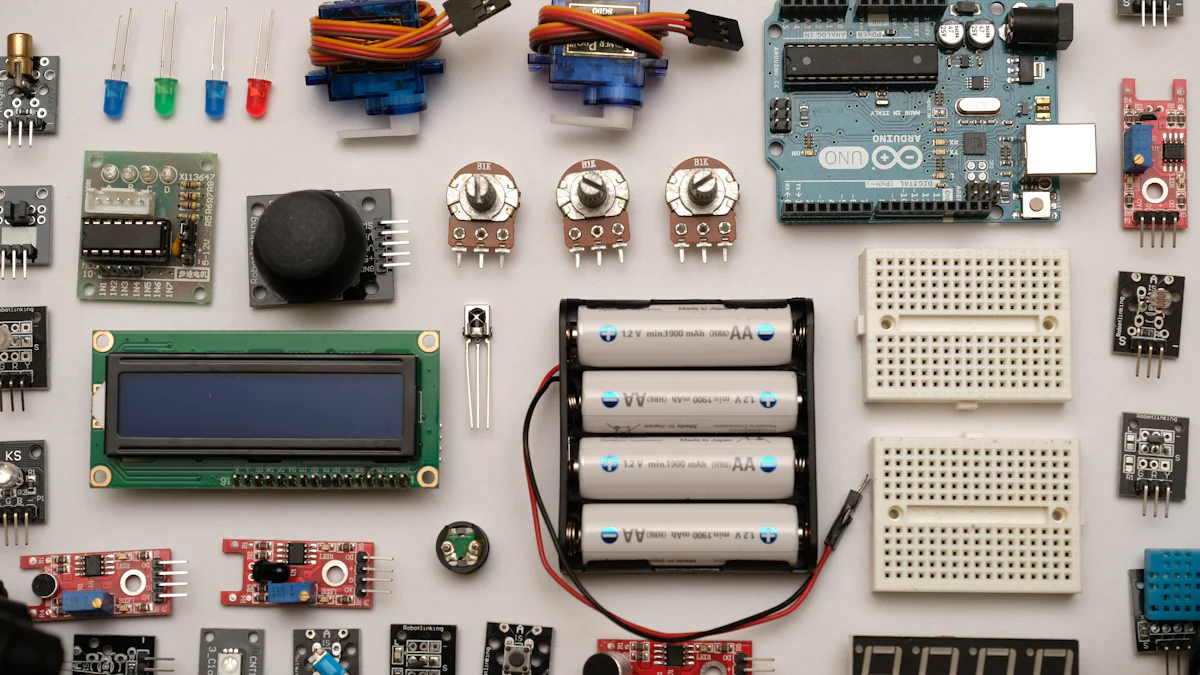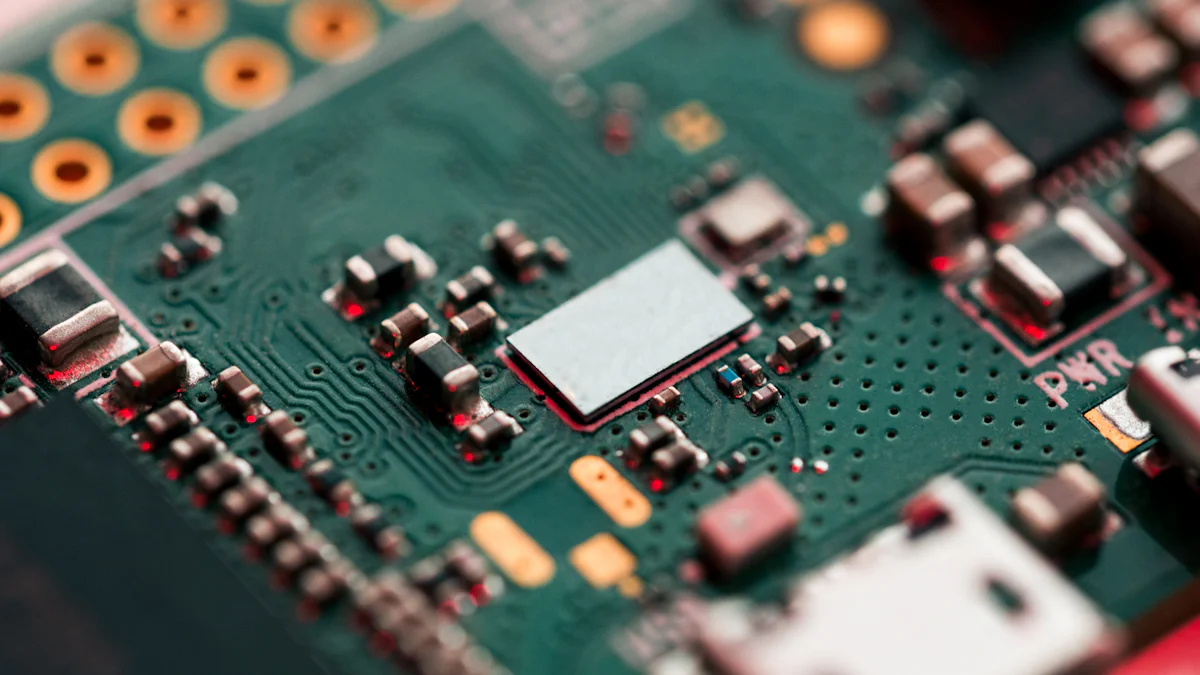Oscilloscopes and Multimeters Explained for Beginners

You often need reliable tools to work with electronics or electrical systems. Oscilloscopes and multimeters are two of the most common options. A multimeter helps you measure voltage, current, and resistance with precision. It’s perfect for general testing, like checking diodes or transistors. On the other hand, an oscilloscope lets you see how signals change over time. It’s essential for analyzing waveforms and troubleshooting complex devices, such as audio amplifiers or TV receivers. If you’re wondering what does the oscilloscope measure, it captures dynamic signals, showing their frequency, amplitude, and noise. Each tool serves a unique purpose, making them indispensable for different tasks.
Key Takeaways
A multimeter helps measure voltage, current, and resistance. It is great for simple electrical tests and fixing problems.
Digital multimeters are easy to use and show exact results. They are good for beginners because they are simple and cheap.
An oscilloscope shows how electrical signals change over time. It is important for studying waveforms and fixing tricky circuits.
Use a multimeter for steady measurements and simple checks. For changing signals, an oscilloscope works better.
Start with a multimeter to learn basic electronics. Use an oscilloscope for harder tasks when you feel ready.
What is a Multimeter?

Definition and Purpose
A multimeter is an essential tool for anyone working with electronics or electrical systems. It measures three primary parameters: voltage (volts), current (amperage), and resistance (ohms). You can use it to test for continuity in electrical circuits, ensuring electricity flows through a complete pathway. This makes it invaluable for troubleshooting and testing electrical components. Whether you're working on a science project or repairing a household device, a multimeter helps you verify that circuits and components function correctly.
Tip: A multimeter is often the first tool you should reach for when diagnosing electrical issues.
Key Features
Measuring Voltage, Current, and Resistance
Modern multimeters, often referred to as DMMs (digital multimeters), offer a wide range of measurement capabilities. You can measure both AC and DC voltage, AC and DC current, and resistance. These basic functions are crucial for tasks like checking battery levels, testing electrical outlets, or verifying circuit connections.
Analog vs. Digital Multimeters
Multimeters come in two main types: analog and digital. Analog models display readings using a needle on a scale, while digital multimeters show precise numerical values on an LCD screen. For beginners, digital multimeters are easier to use and more accurate. They also include additional features like continuity testing, diode testing, and even temperature measurement.
Note: Digital multimeters are faster and more reliable than analog models, making them the preferred choice for most users.
Advantages
Portability and Ease of Use
A multimeter is compact and lightweight, making it easy to carry around. Its straightforward design allows you to quickly measure electrical parameters without needing advanced technical knowledge. This simplicity makes it an excellent tool for beginners.
Cost-Effectiveness for Beginners
Digital multimeters are affordable and widely available. Despite their low cost, they provide accurate and reliable measurements. For someone just starting with electronics, a DMM offers great value without requiring a significant investment.
Tip: Start with a basic digital multimeter to learn the fundamentals of electrical testing before exploring more advanced tools.
Limitations
Inability to Visualize Waveforms
A multimeter, or DMM, excels at measuring basic electrical parameters like voltage, current, and resistance. However, it cannot show you how these values change over time. This limitation makes it unsuitable for analyzing dynamic signals. For example, if you want to observe the shape of a waveform or detect signal intensity variations, a multimeter won’t help. Oscilloscopes, on the other hand, are designed for this purpose. They display real-time waveforms, allowing you to see how signals behave in a circuit. Multimeters lack this capability because they focus on providing precise numerical readings rather than visual representations.
Note: If your project involves analyzing signal patterns or troubleshooting noise in circuits, you’ll need an oscilloscope instead of a multimeter.
Limited to Steady-State Measurements
Multimeters are best suited for steady-state measurements. They measure fixed or slowly changing electrical values, such as the voltage of a battery or the resistance of a resistor. This makes them ideal for tasks like checking continuity or testing electrical outlets. However, when it comes to capturing fast-changing signals, multimeters fall short. Oscilloscopes outperform DMMs in this area due to their faster measurement engines and wider bandwidths. They can track rapid voltage changes and provide detailed insights into signal behavior. While multimeters offer greater accuracy and resolution for steady-state values, they cannot match the speed and detail of an oscilloscope for dynamic signals.
Tip: Use a multimeter for basic testing and troubleshooting. For advanced analysis, consider investing in an oscilloscope.
What is an Oscilloscope?

Definition and Purpose
An oscilloscope is an electronic test instrument that helps you visualize how electrical signals change over time. It graphically displays varying voltages of one or more signals as a function of time. The x-axis represents time, while the y-axis shows voltage. This tool is essential for debugging, analyzing, and characterizing electrical signals. You can use it to observe signal behavior, detect irregularities, and measure parameters like frequency and amplitude. Whether you're troubleshooting a circuit or analyzing a waveform, an oscilloscope provides the insights you need.
Did you know? Oscilloscopes are commonly used in laboratories and workshops to display waveforms and analyze electronic signals in real-time.
Key Features
Visualizing Waveforms and Signals
One of the oscilloscope's primary functions is to display waveforms. It allows you to see how signals behave in a circuit. For example, you can observe a sine wave, square wave, or any other signal shape. This visual representation helps you understand the signal's characteristics, such as its rise time, distortion, or noise. By using an oscilloscope, you can identify issues like signal interference or unexpected voltage spikes.
Measuring Signal Frequency, Amplitude, and Noise
Oscilloscopes excel at measuring key signal parameters. You can determine the frequency of a signal, which tells you how often it repeats over time. The amplitude shows the signal's strength or voltage level. Additionally, oscilloscopes help you detect noise, which can interfere with a circuit's performance. These measurements are crucial for diagnosing problems and ensuring your circuits function correctly.
Description | |
|---|---|
Bandwidth | Determines the range of frequencies the oscilloscope can accurately reproduce and measure. |
Sampling Rate | The number of measurements per second, affecting the accuracy of readings. |
Triggering | Synchronizes the oscilloscope's measurement with the observed signal, useful for identifying issues. |
Record Length | The duration the oscilloscope can capture and store a signal, impacting the amount of data available for analysis. |
Connectivity | Determines the oscilloscope's capability to measure multiple signals simultaneously. |
Advantages
Real-Time Signal Analysis
Oscilloscopes provide real-time analysis of electrical signals. You can monitor how a signal changes instantly, which is invaluable for troubleshooting. For example, if you're working on a malfunctioning circuit, the oscilloscope lets you pinpoint the exact moment and location of the issue. This capability makes it a powerful tool for engineers and hobbyists alike.
Troubleshooting Complex Circuits
When dealing with intricate circuits, an oscilloscope becomes your best ally. It helps you identify problems that are difficult to detect with other tools. For instance, you can use it to locate noise sources, measure signal timing, or analyze waveform distortions. Its ability to display waveforms and measure dynamic signals makes it indispensable for advanced troubleshooting.
Pro Tip: Modern oscilloscopes come with features like advanced signal processing, waveform storage, and user-friendly interfaces, making them even more versatile.
Limitations
Higher Cost Compared to Multimeters
Oscilloscopes often come with a higher price tag than multimeters. This is due to their advanced features, such as real-time waveform visualization, high sampling rates, and extensive measurement capabilities. While a basic digital multimeter might cost you less than $50, even entry-level oscilloscopes can start at several hundred dollars. Professional-grade models with enhanced bandwidth and precision can cost thousands. For beginners or hobbyists, this initial investment may feel overwhelming. However, the oscilloscope's ability to analyze dynamic signals and troubleshoot complex circuits justifies the cost for advanced users.
Tip: If you're just starting, consider borrowing or using a shared oscilloscope before making a purchase. This allows you to explore its features without committing to the expense.
Steeper Learning Curve for Beginners
Using an oscilloscope can be challenging when you're new to electronics. Unlike a multimeter, which provides straightforward numerical readings, an oscilloscope requires you to interpret graphical waveforms. You need to understand concepts like triggering, bandwidth, and sampling rates to use it effectively. The numerous buttons, knobs, and settings on the device can feel intimidating at first. Digital oscilloscopes, while powerful, may introduce additional complexities. For instance, digitization can sometimes affect signal fidelity, leading to artifacts like jitter or edge distortion. Beginners may also struggle with the oscilloscope's limited dynamic range, which can cause signal clipping if the input voltage exceeds its capacity.
Did you know? Many modern oscilloscopes include tutorials and guided modes to help you learn the basics. These features can make the learning process smoother.
Despite these challenges, mastering an oscilloscope is worth the effort. It opens up opportunities to analyze signals in ways that multimeters cannot. With practice, you'll gain confidence in navigating its features and interpreting waveforms.
Oscilloscope vs Multimeter: Key Differences
Functionality
Multimeters for Basic Measurements
A multimeter, often referred to as a DMM, is your go-to tool for basic electrical measurements. It provides precise numerical readings for voltage, current, and resistance. This makes it ideal for tasks like testing batteries, checking electrical outlets, or verifying circuit connections. Many modern multimeters also include advanced features such as diode testing and conductance measurement, which add versatility to their functionality. If you need a straightforward tool for diagnosing electrical issues, a multimeter is the perfect choice.
Tip: Use a multimeter when you need accurate, steady-state measurements without the need for visualizing signal changes.
Oscilloscopes for Signal Visualization
An oscilloscope, on the other hand, excels at visualizing electrical signals. It displays waveforms on a screen, allowing you to see how voltage changes over time. This makes it invaluable for analyzing dynamic signals, such as those in audio equipment or communication systems. Unlike a multimeter, an oscilloscope can differentiate between waveforms like sine waves and square waves. If your project involves real-time signal analysis, an oscilloscope is the better tool.
Did you know? Oscilloscopes can also measure signal timing, amplitude, and noise, making them essential for troubleshooting complex circuits.
Measurement Capabilities
Multimeters for Steady-State Measurements
Multimeters are designed to measure fixed or slowly changing values. They provide high accuracy for specific parameters like voltage, current, and resistance. For example, you can use a DMM to check the voltage of a battery or the resistance of a resistor. However, multimeters cannot capture rapid changes in signals, which limits their use in dynamic environments.
Oscilloscopes for Dynamic Signal Analysis
Oscilloscopes specialize in analyzing signals that change rapidly over time. They visually display how voltage varies, offering insights into waveform shape, frequency, and amplitude. While they may not match the pinpoint accuracy of a multimeter for steady-state values, their ability to analyze dynamic signals makes them indispensable for advanced engineering tasks.
Feature | Multimeter | Oscilloscope |
|---|---|---|
Measurement Type | Provides precise numerical values for voltage, current, resistance | Visually displays how voltage signals vary over time |
Accuracy | High accuracy for specific measurements | Less fine accuracy but detailed waveform analysis |
Functionality | Measures voltage, current, resistance, and more | Measures wave shapes, amplitude, and frequency |
Applications | General measurements, testing components | Intensive engineering work, signal analysis |
Limitations | Cannot measure voltage change over time | Cannot provide precise numerical values |
Cost and Accessibility
Multimeters as Budget-Friendly Tools
Multimeters are generally more affordable than oscilloscopes. A basic digital multimeter can cost as little as $20, making it an excellent choice for beginners. Even advanced models with features like data logging remain budget-friendly. This affordability allows you to start learning about electronics without a significant financial commitment.
Oscilloscopes as an Investment for Advanced Users
Oscilloscopes, due to their complexity, come with a higher price tag. Entry-level models start at a few hundred dollars, while professional-grade devices can cost thousands. However, their ability to analyze dynamic signals and troubleshoot intricate circuits justifies the investment for advanced users. If you're serious about electronics, an oscilloscope is a valuable addition to your toolkit.
Note: For beginners, borrowing or sharing an oscilloscope can help you explore its features before making a purchase.
Learning Curve
Multimeters as Beginner-Friendly
If you're new to electronics, a multimeter is the perfect tool to start with. Its design focuses on simplicity, making it easy for you to measure voltage, current, and resistance without prior experience. Most digital multimeters (DMMs) feature a user-friendly interface with clear labels and straightforward controls. You only need to select the correct measurement mode, connect the probes, and read the values on the screen.
Tip: Look for a multimeter with an auto-ranging feature. It automatically selects the appropriate range for your measurement, saving you time and effort.
Multimeters also come with built-in safety features, such as overload protection, to prevent damage to the device or your circuit. This makes them a safe choice for beginners. Additionally, their portability allows you to carry them anywhere, whether you're working on a school project or fixing a household appliance.
You don't need advanced knowledge to use a multimeter effectively. With a little practice, you can quickly learn to test batteries, check electrical outlets, or measure resistance in a circuit. This ease of use makes multimeters an essential tool for anyone starting their electronics journey.
Oscilloscopes Requiring More Technical Knowledge
Oscilloscopes, while powerful, demand a deeper understanding of electronics. Unlike multimeters, they display waveforms on a screen, requiring you to interpret graphical data. You need to grasp concepts like time divisions, voltage scales, and triggering to use an oscilloscope effectively.
Did you know? Triggering helps you stabilize a waveform on the screen, making it easier to analyze.
The controls on an oscilloscope can feel overwhelming at first. You’ll encounter knobs and buttons for adjusting settings like bandwidth, sampling rate, and vertical scaling. These features provide advanced functionality but require practice to master.
Modern oscilloscopes often include tutorials and guided modes to help you get started. However, you’ll still need to invest time in learning how to analyze waveforms and troubleshoot circuits. If you're willing to put in the effort, an oscilloscope can unlock a deeper understanding of signal behavior and circuit performance.
Pro Tip: Start with simple experiments, like observing a sine wave from a signal generator, to build your confidence with an oscilloscope.
Applications and Use Cases
When to Use a Multimeter
Checking battery voltage
You can use a multimeter to check if a battery is still functional. Set the multimeter to measure DC voltage, connect the probes to the battery terminals, and read the voltage. This helps you determine if the battery needs replacement or recharging. For rechargeable batteries, you can monitor their voltage over time to ensure they charge correctly.
Testing electrical outlets
A multimeter is essential for testing outlets in your home. By measuring the AC voltage, you can confirm if an outlet is delivering the correct voltage. This ensures the safety and functionality of your electrical system. You can also use it to troubleshoot faulty outlets or verify if a circuit breaker is working properly.
Measuring resistance in circuits
Multimeters allow you to measure resistance in various components, such as resistors or wires. This helps you identify faulty parts or ensure proper connections in a circuit. For example, you can test the resistance of a wire to check for breaks or measure the resistance of a resistor to verify its value.
Tip: Use the continuity mode on your multimeter to quickly check if two points in a circuit are connected.
When to Use an Oscilloscope
Analyzing signal waveforms in electronics
Oscilloscopes let you visualize how signals behave in a circuit. For example, you can observe the shape of a sine wave or square wave to understand its characteristics. This is especially useful when designing or troubleshooting electronic devices.
Troubleshooting noise in circuits
If your circuit is malfunctioning, an oscilloscope can help you identify noise or interference. By displaying the waveform, you can pinpoint irregularities, such as voltage spikes or unexpected distortions, and take corrective action.
Measuring signal timing and frequency
Oscilloscopes excel at measuring the timing and frequency of signals. For instance, you can use one to determine how often a signal repeats or to measure the time delay between two signals. This is crucial for applications like synchronizing components in a circuit.
Did you know? Oscilloscopes are widely used in fields like automotive diagnostics, engineering, and even medicine for analyzing signals.
Examples for Beginners
Multimeter: Testing a simple circuit
Start by testing a basic circuit with a multimeter. For example, you can measure the voltage across a battery powering a light bulb. Use the probes to touch the battery terminals and observe the reading. You can also check the bulb's resistance to ensure it’s functional.
Oscilloscope: Observing a square wave from a signal generator
A great beginner project with an oscilloscope is observing a square wave. Connect the oscilloscope to a signal generator, set the generator to produce a square wave, and adjust the oscilloscope settings to display the waveform. This helps you understand how oscilloscopes visualize signals.
Pro Tip: Practice using the oscilloscope’s triggering feature to stabilize the waveform on the screen.
Oscilloscopes and multimeters serve different purposes, and understanding their strengths helps you make informed decisions. Multimeters excel in providing precise numerical values for voltage, current, and resistance. They are affordable, easy to use, and ideal for simpler applications. Oscilloscopes, however, shine in troubleshooting complex circuits by visually displaying waveforms and analyzing transient signals. If you are a beginner, start with a multimeter to learn the basics. For advanced tasks, an oscilloscope becomes essential when working with dynamic signals or diagnosing intricate issues.
When choosing between these tools, consider the type of measurements you need. Multimeters work best for high-accuracy checks, while oscilloscopes handle complex signals effectively. Avoid common mistakes like improper probe connections or incorrect settings, as these can hinder troubleshooting efforts. Always align your choice with the complexity of your tasks and your budget.
FAQ
1. Can you use a multimeter to measure AC signals?
Yes, you can measure AC voltage and current with a multimeter. Set it to the appropriate AC mode, connect the probes, and read the values. However, it cannot show how the signal changes over time. For that, you need an oscilloscope.
Tip: Always ensure the multimeter's range matches the signal's expected value.
2. What is the difference between bandwidth and sampling rate in an oscilloscope?
Bandwidth determines the range of frequencies the oscilloscope can measure accurately. Sampling rate refers to how many data points the oscilloscope captures per second. Higher bandwidth and sampling rates provide better signal detail.
Did you know? A low sampling rate can miss fast signal changes, leading to inaccurate waveforms.
3. Which tool should you buy first as a beginner?
Start with a digital multimeter. It’s affordable, easy to use, and perfect for basic tasks like checking voltage or resistance. Once you’re comfortable with electronics, consider an oscilloscope for advanced signal analysis.
Pro Tip: Look for a multimeter with auto-ranging to simplify your measurements.
4. Can an oscilloscope replace a multimeter?
No, an oscilloscope cannot replace a multimeter. Oscilloscopes excel at visualizing signals, but they lack the precision and simplicity of multimeters for steady-state measurements like resistance or DC voltage.
Note: Use both tools together for comprehensive circuit analysis.
5. How do you safely use a multimeter or oscilloscope?
Always check the tool’s voltage and current limits before connecting it to a circuit. Use insulated probes and avoid touching exposed wires. For oscilloscopes, ensure the ground clip is properly connected to avoid damage.
Safety Tip: Wear insulated gloves when working with high-voltage circuits.
See Also
Essential Circuit Board Parts Every Newbie Must Understand
Understanding 1k Resistors: A Simple Guide for Beginners
Step-by-Step Guide to Testing HVAC Capacitors Using Multimeter
Key Historical Developments in Integrated Circuit Technology Explained
